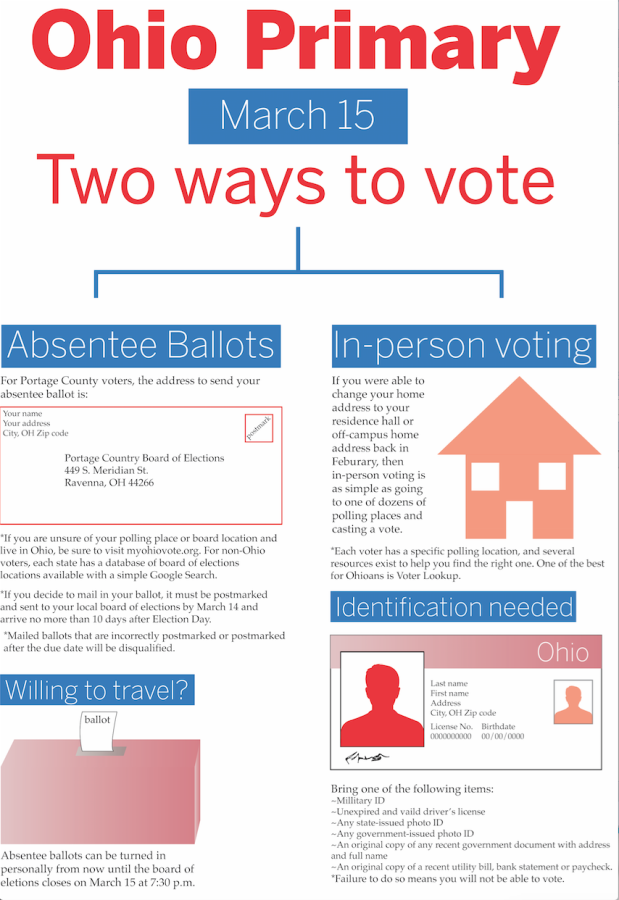What to do before voting in the Ohio primary
March 6, 2016
After weeks of following the endless coverage of national caucuses and primaries, one of the nation’s biggest swing state competitions, the Ohio primary, will take place March 15.
Voting for primaries is important, especially in a state like Ohio, where voters’ decisions could spell the end for campaigns and victory for others.
There are two ways to vote: absentee ballots or in-person voting.
Absentee voting is often the preferred method of voting for college students, who are either still registered to vote in their hometowns or know they will be busy on Election Day.
Last week, the Portage County Board of Elections reported that more than half of the absentee ballots they sent out have not been returned.
This means nearly 1,000 Portage County voters have not turned in those ballots.
Fortunately, if you are one of these 1,000 voters, turning in your ballot is an easy and quick process.
For Portage County voters, the address to send your absentee ballots is 449 South Meridian St. in Ravenna, Ohio.
If voters are unsure of their polling place or board location and live in Ohio, they should be sure to visit myohiovote.org.
For non-Ohio voters, each state has a database of Board of Elections locations available with a simple Google search.
Those Portage County voters willing to travel to the Ravenna board itself can personally turn in their absentee ballots from now until the building closes on March 15 at 7:30 p.m.
If a voter’s board location is outside of Portage County, each board has an official government website that clearly displays the hours it will be open on Election Day.
Again, this information is made clear through a simple Google search.
On the other hand, if a voter decides to mail in their ballot, it must be postmarked and sent to their local Board of Elections by March 14 and arrive no more than 10 days after the election.
Mailed ballots that are incorrectly postmarked or postmarked after the due date will be disqualified.
As for in-person voting, the rules are a bit different.
If an individual was unable to change their home address to their residence hall or off-campus home address back in February, then in-person voting is as simple as arriving at one of dozens of polling places and casting a vote.
Each voter has a specific polling place and several resources exist to help them find the right one.
One of the best resources for Ohioans is Voter Lookup, a state-sponsored website that allows Ohio voters to find out exactly where they need to go in order to vote for the upcoming election.
All that’s needed for an individual to do is type in their full name and provide their county information, and the address of their polling place will be instantly generated.
The process takes seconds and is available at voterlookup.sos.state.oh.us.
Ohio has voter identification laws in place, so all voters must bring one of the following items to their polling place to prove their identity:
- Military ID
- Unexpired and valid driver’s license
- Any state-issued photo ID
- Any government issued photo ID1
- An original copy of any recent government document with address and full name
- An original copy of a recent utility bill, bank statement or paycheck
Failure to do so means a person will not be able to vote.
Mitch Felan is a political correspondent for The Kent Stater. Contact him at [email protected].












